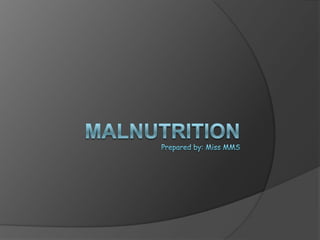
Malnutrition
- 2. Introduction Malnutrition is failing health that result from not eating a balance diet over a long period of time. Malnutrition refers to undernutrition resulting from inadequate consumption or excessive loss of nutrients It can also refer to overnutrition resulting from overeating or excessive intake of specific nutrients.
- 3. Some Effects of Malnutrition Kwashiorkor Caused by protein deficiency Often due to poverty in developing nations. Families cannot afford to feed their young children with high protein food after the children have stopped feeding on mother‟s milk It can be prevented by giving sufficient food containing protein food to young children Symptoms are: ○ Swelling of the legs ○ Underweight ○ “moon face” ○ Swollen abdomen („pot belly‟) ○ Thin muscles but fat present ○ Dry, sparse, thin hair ○ Apathetic, little interest in his surrounding ○ Stunted growth
- 5. Marasmus Caused by deficiency of energy and protein foods in children Symptoms of marasmus are: ○ Underweight ○ „Old man face‟ ○ Thin muscles, thin fat ○ Stunted growth
- 6. Excessive Intake of Lipids Atherosclerosis Caused by diets rich in saturated fats and cholesterol The cholesterol deposited below the inner lining of the arterial wall to form plagues. The plagues gradually become thicker and harder If the coronary artery to the heart is partially blocked, the person may feel intense chest pain during strenuous physical exercise or emotional stress. This is because inadequate oxygen is being supplied to the heart muscles for increased activities
- 7. Continue… As the coronary artery becomes more blocked, there is insufficient supply O2 to the heart muscles. This leads to a heart attack (myocardial infarction)
- 8. Hypertension Blood pressure is the force of the blood exerted on the walls of the blood vessels The normal blood pressure for an adult is 120/80 mmHg May be due to narrowing of the lumen of arteries and reduced elasticity The heart has to pump harder to force the blood through the vessels Hypertension usually gives a measurement of blood at 140/90 mmHg or higher It may cause rupture of small arteries in the brain leading to stoke, heart enlargement, heart attack and renal failure Sometimes known as the „silent killer‟. The affected person who does not go for regular medical check-ups may not be aware of it until a stroke or heart attack occurs.
- 10. Prevention A healthy, balanced diet low in saturated fats and cholesterol with sufficient antioxidant vitamins (vit. A, C and E), whole grain cereals, nuts, leafy vegetables and fruits may help to prevent cardiovascular disease Regular moderate exercise
- 11. Excessive Intake of Carbohydrates Diabetes mellitus Caused by the failure of the pancreas to produce hormone insulin to regulate blood glucose levels. The kidneys are unable to reabsorb the glucose. Excess glucose is removed in the urine.
- 12. Prevention Moderate daily exercises, maintaining proper weight, eating a balanced diet containing unrefined carbohydrates and not smoking People with mild forms of diabetes can control their diet and limit the amount and type of carbohydrate They should avoid taking simple sugars In more severe cases, diabetics require daily insulin injections Diabetes is not treated, can lead to kidney failure, cataracts, blindness (diabetes meningitis) and heart disorder. Wounds will also be slow to heal
- 15. Effects of Calcium Deficiency Osteoporosis Generally associated with aging. Factors that increase the risk include low dietary intake of calcium and vit. D It is also caused by decreasing levels of hormones, for eg. Oestrogen in females after menopause In osteoporosis, there is a progressive loss of bone density and mineral content. The bones become thinner, more porous and fracture easily, especially at the hips, backbone and wrist
- 17. Prevention It is suggested that people in mid-twenties and older consume dairy products daily Regular moderate exercises and not smoking
- 18. Rickets Rickets is a softening of bones in children due to deficiency or impaired metabolism of vitamin D, phosphorus or calcium, potentially leading to fractures and deformity. The predominant cause is a vitamin D deficiency, but lack of adequate calcium in the diet may also lead to rickets (cases of severe diarrhoea and vomiting may be the cause of the deficiency). Although it can occur in adults, the majority of cases occur in children suffering from severe malnutrition, usually resulting from famine or starvation during the early stages of childhood.
- 20. The End ~ Appreciate what we have in our life ~
